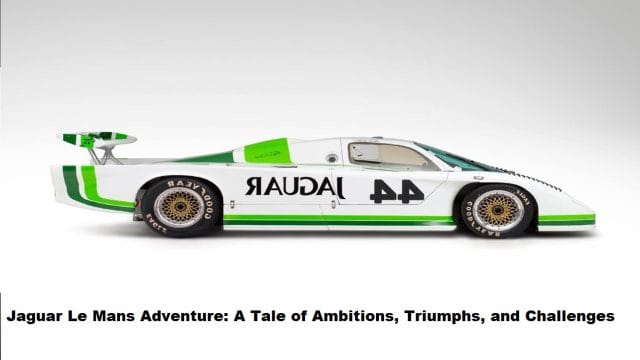Jaguar Le Mans Adventure: In 1988, I saw the Jaguar XJR-9LM racing vehicle piloted by Andy Wallace, Jan Lammers, and Johnnie Dumfries complete Le Mans. I hear history now. Everyone was excited and tense when Porsche fell after seven straight wins. The throng appeared cheerful, dancing and letting off steam.
Despite this bliss, harsh times erased memories. Last year, everyone whispered “what if” since the Jaguars came so close to winning. We didn’t comprehend that a thin rod holding gears dictated fame or obscurity. This was hidden from us. Like buried gems, stories like that lurk in our minds. Let me tell you a global tale. Jaguar’s comeback to Le Mans takes place in another universe.
If Bob Tullius’s racing team hadn’t gone out of business eight years ago, would his life have been different? Guessing is a problem that’s hard to avoid. Even in another universe, Tom Walkinshaw might have utilized his innovation to help the XJ-S win the European Touring Car Championship. After that, he may have traveled to design a Jaguar Group C automobile. Tullius’ Group 44 project won IMSA races with its model.
Let’s ignore that Tullius worked alone and was unrelated to Jaguar’s environment. The artwork spans many locations. Jaguar’s North American marketing chief, Mike Dale, created a great proposal. The project was more than physical. The new chairman’s strong ink released Jaguar from Leyland’s grip in 1981. TWR would function like Group 44 and Jaguar.
Group 44 created the XJR-5. This car’s metal chassis contained Jaguar’s reliable V12 engine. The drawing met IMSA and Le Man’s criteria. The turbocharged Porsche 935 and March Porsche 83G outperformed the XJR-5. Its 1984 Le Mans performance was less significant than the giant Porsche’s.
1985’s XJR-5 resumed the narrative. The stage and script were ready. Tullius and his followers had to climb a difficult hill when their triumph trip went awry. GTP won despite racing problems. Despite attempts to stop it, a change occurred. TWR took over Jaguar’s Le Mans project, signaling new leadership.
Tullius, who led his musical ensemble, extended his notes to help Walkinshaw introduce himself. TWR’s XJR-6, a superior XJR-5, showed Jaguar’s return. Brian Redman, who represents these accounts, accurately describes this time. The exact Group 44 team impressed him. Sadly, they fought Porsche’s Goliath, a strong automobile with a conventional car engine.

TWR-managed Jaguar’s XJR-8 won the competition. Eight victories in 1990 were significant. It was a huge success, everyone heard. The Le Mans diamond eluded them. It was a fleeting dream.
The 1991 Le Man’s racing tale became strange as the sun rose. The field has several conflicts and vacant places. The picture included anticipated and surprising elements. This weaving developed a unique pattern. The projected pole position was slower than the surprise 11th. Its appearance and operation were a mystery with a Jaguar logo.
Even if it’s less popular, Jaguar’s Le Mans adventure is still part of racing’s fascinating history. Jaguar’s ambitions synced with time as engines roared and tires touched the road. Achievement and issue sound produce a long-lasting tune.
READ MORE: Shane van Gisbergen Makes NASCAR Move: Departing Supercars for Thrills
Our Reader’s Queries
Did Jaguar ever win Le Mans?
Despite not being the most successful manufacturer at Le Mans, Jaguar still holds an impressive record with seven wins. The British marque currently ranks fourth behind Porsche, Audi, and Ferrari. However, Jaguar’s achievements should not be overlooked as they have made a significant impact in the history of the prestigious endurance race.
When did Jaguar return to Le Mans?
In 1984, Jaguar made a much-anticipated comeback to Le Mans by partnering with the American Group 44 team. Together, they created a sports racing car that was powered by the Jaguar V12 engine. Unfortunately, both of the cars that were entered in the race failed to finish. Nonetheless, this marked an important moment in Jaguar’s racing history and demonstrated their commitment to pushing the boundaries of automotive engineering.
Did AC type Jaguar win Le Mans?
Back in 1951, the Jaguar C-type made history as the first of our vehicles to triumph at the prestigious 24 Hours of Le Mans. It shattered speed and distance records, achieving this feat on its very first try.
What is the most dominant car at Le Mans?
While the Audi R8 holds the official record for most victories by a single car at Le Mans with five wins, it’s worth noting that the Bentley Speed 8 also used the same chassis and engine, bringing the total to six wins. However, let’s not forget about the impressive Porsche 917/956/919 models that have also made their mark on the iconic race track. These technically advanced vehicles have left a lasting impression on the world of motorsports and continue to be admired by enthusiasts worldwide.
